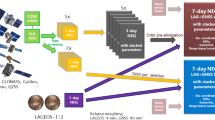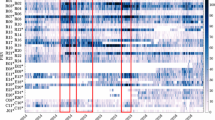Abstract
Chang’E-3 is China’s first lunar surface exploration mission, as a part of the second phase of China’s Lunar Exploration Program (CLEP). It landed successfully in the northwest of Mare Imbrium on December 14, 2013, incorporating two probes, a lander and a rover named Yutu. The execution of the cooperative science tasks required an accurate determination of the relative position between the lander and the rover. In-beam phase referencing experiments have been conducted with the Chinese VLBI Network (CVN) to accurately image the rover in reference to the stationary lander in order to obtain their offsets in Right Ascension and Declination, which were then transformed into the lunar local coordinate system to acquire their relative position on the lunar surface. The observations and the data processing procedures are described in this paper. Images of the rover in six epochs between December 15 and 21, 2013 were made, resulting in accurate positions of the rover that are consistent with the visual localization approach. Through measurement of the locations of the rover’s omnidirectional antenna with respect to the lander’s directional antenna before their separation, and the recognition of the rover’s turning actions during its exploratory moves, we demonstrate that the accuracy of relative position determined in this way could reach the meter level and the resolution is better than 1 meter.
抽象
创新点
利用嫦娥三号任务数据开展了双探测器同波束相位参考干涉测量试验, 获得了玉兔号巡视器在几个月面探测点相对着陆器的位置, 定位精度达到米级, 对巡视器精细运动的分辨力优于 1m.
Similar content being viewed by others
References
Lanyi G, Border J S, Benson J S, et al. Determination of angular separation between spacecraft and quasars with the Very Long Baseline Array. JPL: IPN Progress Report 42–162. 2005
Curkendall D W, Border J S. Delta-DOR: the one-nanoradian navigation measurement system of the deep space network-History, Architecture, and Componentry. JPL: IPN Progress Report 42–193. 2013
Martin-Mur T J, Antreasian P, Border J S, et al. Use of very long baseline array interferometric data for spacecraft navigation. In: Proceedings of the 19th International Symposium on Space Flight Dynamics, Kanazawa, 2006. ISTS 2006-d-50
Jones D L, Fomalont E, Dhawan V, et al. Very Long Baseline Array astrometric observations of the Cassini spacecraft at Saturn. Astron J, 2011, 141: 29–45
Martin-Mur T J, Highsmith D E. Mars approach navigation using the VLBA. In: Proceedings of the 21st International Symposium on Space Flight Dynamics, Toulouse, 2009. 1–10
Fomalont E, Martin-Mur T J, Border J S, et al. Spacecraft navigation using the VLBA. In: Proceedings of the 10th European VLBI Network Symposium and EVN Users Meeting: VLBI and the New Generation of Radio Arrays, Manchester, 2010. 66F
Duev D A, Calves G M, Pogrebenko S V, et al. Spacecraft VLBI and Doppler tracking: algorithms and implementation. Astron Astrophys, 2012, 541: A43
Beasley A J, Conway J E. VLBI phase-referencing. In: Zensus J A, Diamond P J, Napier P J, et al., eds. Very Long Baseline Interferometry and the VLBA. San Francisco: ASP, 1995. 327–341
Guirado J C, Ros E, Jones D L, et al. Space-VLBI phase-reference mapping and astrometry. Astron Astrophys, 2001, 371: 766–770
Majid W A, Bagri D S. Precision spacecraft tracking using in-beam phase referencing. In: Proceedings of the 2008 IEEE Aerospace Conference, BigSky, 2008. 1–7
Huang Y, Chang S Q, Li P J, et al. Orbit determination of Chang’E-3 and positioning of the lander and the rover. Chin Sci Bull, 2014, 59: 3858–3867
Zhang X Z, Shu F C, Xiang Y, et al. VLBI technology development at ShAO. In: Proceedings of the 6th IVS General Meeting, Hobart, 2010. 383–387
Zheng W M, Quan Y, Shu F C, et al. The software correlator of the Chinese VLBI Network. In: Proceedings of the 6th IVS General Meeting, Hobart, 2010. 157–161
Sekido M, Fukushima T. A VLBI delay model for radio sources at a nite distance. J Geodesy, 2006, 80: 137–149
Shu F C, Zhang X Z, Kondo T. Development of correlator model for differential VLBI observations of satellites. In: Proceedings of the International Conference on Microwave and Millimeter Wave Technology, Nanjing, 2008. 443–446
Guo L, Zheng X W, Zhang B. New determination of the position of the pulsar B0329+2B54 with Chinese VLBI network. Sci China-Phys Mech Astron, 2010, 53: 1559–1564
Cao J F, Huang Y, Hu X G, et al. Mars Express tracking and orbit determination trials with Chinese VLBI network. Chin Sci Bull, 2010, 55: 3654–3660
Zheng W M, Luo W C. CVN software correlator development and applications in Chinese Lunar Exploration Mission. In: Proceedings of the 5th IVS General Meeting, St. Petersburg, 2008. 129–133
Ma M L, Zheng W M, Li J L, et al. Accurate determination of impact epoch and coordinate of ChangE-1 Satellite on the Moon. J Astronaut, 2011, 32: 477–481
Huang Y, Hu X G, Zhang X Z, et al. Improvement of orbit determination for geostationary satellites with VLBI tracking. Chin Sci Bull, 2011, 56: 2765–2772
Thompson A R, Moran J M, Swenson J G. Interferometry and Synthesis in Radio Astronomy. 2nd ed. New York: John Wiley & Sons, 2001
Greisen E, Bridle A. AIPS Cookbook. National Radio Astronomy Observatory, 2013
Taylory G. Difmap Cookbook. California Institute of Technology. Pasadena, 1997
Nistér D, Naroditsky O, Bergen J. Visual odometry. In: Proceedings of the IEEE Computer Society Conference on Computer Vision and Pattern Recognition, Washington, 2004. 652–659
Wang B F, Zhou J L, Tang G S, et al. Research on visual localization method of lunar rover (in Chinese). Sci China Inf Sci, 2014, 44: 452–460
Author information
Authors and Affiliations
Corresponding author
Rights and permissions
About this article
Cite this article
Zhou, H., Li, H. & Dong, G. Relative position determination between Chang’E-3 lander and rover using in-beam phase referencing. Sci. China Inf. Sci. 58, 1–10 (2015). https://doi.org/10.1007/s11432-015-5363-1
Received:
Accepted:
Published:
Issue Date:
DOI: https://doi.org/10.1007/s11432-015-5363-1
Keywords
- Chang’E-3
- relative position determination
- in-beam phase referencing
- Chinese VLBI Network
- lunar exploration




